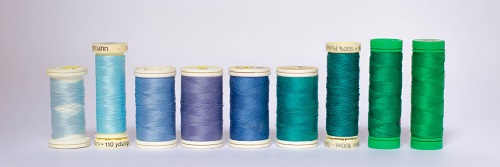
What is Yarn Count–Definition
Yarn Count in Textiles: Understanding Thickness and Weight
Yarn count serves as a numeric indicator defining a yarn’s thickness, fineness, or weight.
It represents the number of hanks (a unit of length) in one pound of yarn. But what exactly is a hank?
A hank denotes a linear value, specifically 840 yards. Therefore, if one pound of yarn measures 840 yards in length, its numeric value is one count. Here’s the correlation: the higher the count, the finer or lighter the yarn; conversely, lower counts indicate thicker yarns.
Yarns encompass a variety of natural and man-made fibers, including cotton, polyester, viscose, acrylic, linen, bamboo, hemp, or blends of these fibers.
Understanding yarn count is pivotal for both novices and professionals in the textile industry. It’s a key aspect in determining a yarn’s characteristics, aiding in selecting the right yarn for specific textile applications.
The count system facilitates consistency and accuracy in describing yarn thickness across different fiber types and production processes. If you’re seeking further clarification or have more questions, don’t hesitate to inquire in the comments below. We’re here to assist and share our knowledge.
Types Yarn Count
Yarn count is categorized into various systems, each defining yarn thickness or fineness differently. Some major types of yarn count include:
- Direct Count System: Measures the length of yarn in a fixed weight. Example: Denier (grams per 9,000 meters), Tex (grams per 1,000 meters).
- Indirect Count System: Indicates the weight of yarn in a fixed length. Examples: Cotton Count (number of hanks of 840 yards per pound), Woollen Count (number of 256 yards per pound), Linen Count (number of leas of 300 yards per pound).
- Metric Count System: Measures yarn fineness by the weight in grams per kilometer of yarn. Example: Ne (number of 1,000-meter lengths per kilogram).
- Worsted Count System: Predominantly used for worsted and woolen yarns. Indicates the number of 560-yard hanks in one pound of yarn. Example: Spun woolen count.
Each system caters to specific types of fibers, production methods, or textile applications, providing a standardized way to communicate yarn thickness and weight across the textile industry. The choice of count system depends on the type of yarn, the intended use, and regional preferences within the textile manufacturing process.
FAQ
Yarn count is an important aspect in textiles. Here’s a FAQ to help:
1. What is yarn count?
Yarn count refers to the numerical measurement of the fineness or thickness of a yarn.
2. How is yarn count measured?
Yarn count can be measured in various systems, including the direct system (length per unit mass) or the indirect system (mass per unit length). Common units include denier, tex, cotton count, worsted count, etc.
3. What does a higher yarn count indicate?
A higher yarn count signifies a finer yarn (thinner), while a lower count indicates a thicker yarn. For instance, a yarn with a count of 80s is finer than one with a count of 40s.
4. What factors influence yarn count?
Fiber type, spinning method, and the number of fibers twisted together to form the yarn affect the yarn count.
5. How is yarn count important in textiles?
Yarn count impacts fabric properties like thickness, softness, strength, and drape. It also influences the appearance and texture of the fabric.
More About Yarn Count Definition
6. Which industries use yarn count as a crucial parameter?
Textile manufacturers, fashion designers, and those involved in producing fabrics or yarn-based products heavily rely on yarn count for quality control and product development.
7. What’s the relation between yarn count and fabric density?
Yarn count, along with fabric construction (weave, knit), determines fabric density. Finer yarns can be woven or knitted more densely to create a higher thread count fabric.
8. Does a higher yarn count always mean better quality?
Not necessarily. The desired yarn count varies based on the intended use of the fabric. For instance, while finer yarns are suitable for soft and lightweight fabrics, coarser yarns might be preferred for durability in heavy-duty applications.
9. How can I choose the right yarn count for my project?
Consider the intended use, desired characteristics of the fabric, and the properties required (strength, texture, appearance) to select an appropriate yarn count.
10. Can yarn count affect the cost of textiles?
Yes, finer yarns often require more processing and higher-quality raw materials, which can increase production costs and, subsequently, the cost of the final textile product.
Understanding yarn count is crucial in the textile industry as it impacts the quality, appearance, and functionality of fabrics.
YARN COUNT DESCRIPTION
Yarn count refers to the numerical measurement determining the thickness or fineness of a yarn within the textile industry. It is a crucial parameter that influences the fabric’s characteristics, appearance, and performance. The count indicates the relationship between the length and weight of the yarn or the weight and length of the yarn, depending on the measurement system used.
In the direct count system, the length of yarn in a fixed weight (often in grams or ounces) determines the count, whereas the indirect count system calculates the weight of yarn in a fixed length (such as meters or yards). Various units measure yarn count, including denier, tex, Ne, cotton count, and worsted count, among others.
A higher yarn count indicates a finer yarn, while a lower count signifies a thicker yarn. This count affects fabric properties like texture, strength, flexibility, and appearance. For instance, fine yarns produce smoother and softer fabrics suitable for delicate garments, while thicker yarns create heavier, more robust textiles. Yarn count selection depends on the intended use of the fabric, desired characteristics, and the manufacturing process, making it a fundamental aspect of textile production and design.
